CCK-8 and CCK-58 differ in their effects on nocturnal solid meal pattern in undisturbed rats
- PMID: 22874423
- PMCID: PMC3469663
- DOI: 10.1152/ajpregu.00365.2011
CCK-8 and CCK-58 differ in their effects on nocturnal solid meal pattern in undisturbed rats
Abstract
Various molecular forms of CCK reduce food intake in rats. Although CCK-8 is the most studied form, we reported that CCK-58 is the only detectable endocrine peptide form in rats. We investigated the dark-phase rat chow intake pattern following injection of CCK-8 and CCK-58. Ad libitum-fed male Sprague-Dawley rats were intraperitoneally injected with CCK-8, CCK-58 (0.6, 1.8, and 5.2 nmol/kg), or vehicle. Food intake pattern was assessed during the dark phase using an automated weighing system that allowed continuous undisturbed monitoring of physiological eating behavior. Both CCK-8 and CCK-58 dose dependently reduced 1-h, dark-phase food intake, with an equimolar dose of 1.8 nmol being similarly effective (-49% and -44%). CCK-58 increased the latency to the first meal, whereas CCK-8 did not. The intermeal interval was reduced after CCK-8 (1.8 nmol/kg, -41%) but not after CCK-58. At this dose, CCK-8 increased the satiety ratio by 80% and CCK-58 by 160%, respectively, compared with vehicle. When behavior was assessed manually, CCK-8 reduced locomotor activity (-31%), whereas grooming behavior was increased (+59%). CCK-58 affected neither grooming nor locomotor activity. In conclusion, reduction of food intake by CCK-8 and CCK-58 is achieved by differential modulation of food intake microstructure and behavior. These data highlight the importance of studying the molecular forms of peptides that exist in vivo in tissue and circulation of the animal being studied.
Figures
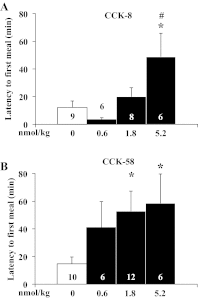
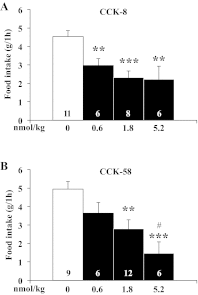



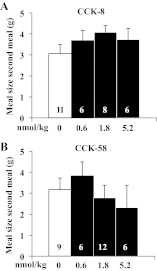
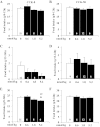

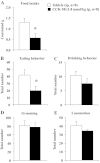
Similar articles
-
CCK-58 elicits both satiety and satiation in rats while CCK-8 elicits only satiation.Peptides. 2014 Apr;54:71-80. doi: 10.1016/j.peptides.2014.01.008. Epub 2014 Jan 24. Peptides. 2014. PMID: 24468546 Free PMC article.
-
The short term satiety peptide cholecystokinin reduces meal size and prolongs intermeal interval.Peptides. 2011 Jun;32(6):1289-95. doi: 10.1016/j.peptides.2011.03.017. Epub 2011 Mar 29. Peptides. 2011. PMID: 21453733
-
Cholecystokinin-33 inhibits meal size and prolongs the subsequent intermeal interval.Peptides. 2011 May;32(5):971-7. doi: 10.1016/j.peptides.2011.02.007. Epub 2011 Feb 16. Peptides. 2011. PMID: 21335043
-
Relationship between the concentration of cholecystokinin-like immunoreactivity in plasma and food intake in male rats.Physiol Behav. 1990 Dec;48(6):859-63. doi: 10.1016/0031-9384(90)90240-5. Physiol Behav. 1990. PMID: 2087518 Review.
-
Effects of cholecystokinin and caerulein on human eating behavior and pain sensation: a review.Psychoneuroendocrinology. 1986;11(1):39-48. doi: 10.1016/0306-4530(86)90030-2. Psychoneuroendocrinology. 1986. PMID: 3085129 Review.
Cited by
-
CCK-58 elicits both satiety and satiation in rats while CCK-8 elicits only satiation.Peptides. 2014 Apr;54:71-80. doi: 10.1016/j.peptides.2014.01.008. Epub 2014 Jan 24. Peptides. 2014. PMID: 24468546 Free PMC article.
-
Cholecystokinin and pancreatic cancer: the chicken or the egg?Am J Physiol Gastrointest Liver Physiol. 2014 Jan;306(2):G91-G101. doi: 10.1152/ajpgi.00301.2013. Epub 2013 Oct 31. Am J Physiol Gastrointest Liver Physiol. 2014. PMID: 24177032 Free PMC article. Review.
-
A new apparatus to analyze meal-related ingestive behaviors in rats fed a complex multi-food diet.Physiol Behav. 2022 Aug 1;252:113824. doi: 10.1016/j.physbeh.2022.113824. Epub 2022 Apr 25. Physiol Behav. 2022. PMID: 35472328 Free PMC article.
-
Satiety Associated with Calorie Restriction and Time-Restricted Feeding: Peripheral Hormones.Adv Nutr. 2022 Jun 1;13(3):792-820. doi: 10.1093/advances/nmac014. Adv Nutr. 2022. PMID: 35191467 Free PMC article. Review.
-
Glutamate-dependent regulation of food intake is altered with age through changes in NMDA receptor phenotypes on vagal afferent neurons.Physiol Behav. 2018 May 15;189:26-31. doi: 10.1016/j.physbeh.2018.02.042. Epub 2018 Feb 21. Physiol Behav. 2018. PMID: 29476874 Free PMC article.
References
-
- Antin J, Gibbs J, Holt J, Young RC, Smith GP. Cholecystokinin elicits the complete behavioral sequence of satiety in rats. J Comp Physiol Psychol 89: 784–790, 1975 - PubMed
-
- Burton-Freeman B, Gietzen DW, Schneeman BO. Cholecystokinin and serotonin receptors in the regulation of fat-induced satiety in rats. Am J Physiol Regul Integr Comp Physiol 276: R429–R434, 1999 - PubMed
Publication types
MeSH terms
Substances
Grants and funding
LinkOut - more resources
Full Text Sources
Other Literature Sources

